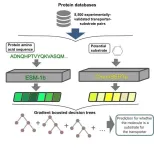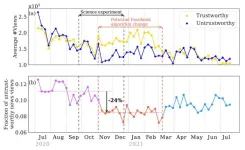(Press-News.org) The risk of being born with a major heart defect is 36% higher in babies who were conceived after assisted reproductive technology, such as in vitro fertilisation (IVF), according to results of a very large study published in the European Heart Journal [1] today (Friday).
Researchers say the finding is important since congenital heart defects are the most common form of birth defects, and some of them are associated with life threatening complications.
The study also shows that the increase in risk is particularly associated with multiple births which are more common in assisted reproduction.
The study was led by Professor Ulla-Britt Wennerholm from the University of Gothenburg in Sweden. She said: “Previous research shows that there are increased risks for babies conceived with the help of assisted reproductive technology. These include preterm birth and low birth weight. We wanted to investigate whether the risk of heart defects was higher for babies born following assisted reproduction.”
The research included all liveborn children born in Denmark between 1994 and 2014, all children born in Finland between 1990 and 2014, those born in Norway between 1984 and 2015 and those born in Sweden from 1987 to 2015; more than 7.7 million in total.
Researchers compared data on babies born following assisted reproduction, including IVF, intracytoplasmic sperm injection (ICSI) and embryo freezing, with data on babies conceived naturally.
They assessed how many liveborn children in each group were diagnosed with a major heart defect or with a serious heart defect either in the womb or in the first year of life. They took into account other factors that can increase the risk of congenital heart defects, such as child’s year of birth, country of birth, mother’s age at delivery, if the mother smoked during pregnancy, or if the mother had diabetes or heart defects.
This showed that heart defects were around 36% more common in babies born after assisted reproduction, compared to babies conceived without such treatment (absolute risk 1.84% versus 1.15%). This risk was similar regardless of the type of assisted reproduction used (IVF or ICSI, fresh or frozen embryos). However, the risk was greater for multiple births following assisted reproduction compared to singleton births following assisted reproduction (2.47% versus 1.62%).
Professor Wennerholm said: “We already know that babies born after assisted reproductive technology have a higher risk of birth defects in general however, we have found a higher risk also in congenital heart defects, the most common major birth defect.
“The fact that the risk of heart defects is similar regardless of the type of assisted reproduction used may indicate that there is some common factor underlying infertility in parents and congenital heart disease in their babies.
“Congenital heart defects can be extremely serious requiring specialist surgery when babies are very young, so knowing which babies are at the greatest risk can help us diagnose heart defects as early as possible and ensure the right care and treatment are given. More and more people are conceiving with the help of assisted reproductive technology, so we might expect to see increases in cases of congenital heart defects worldwide.”
In an accompanying editorial [2] Dr Nathalie Auger from University of Montreal Hospital Research Centre in Canada and colleagues said: “Assisted reproductive technology is a popular intervention in reproductive medicine, with these procedures accounting for 2% to 8% of births depending on the country. While most neonates born after assisted reproductive technology are healthy, these procedures are not without risks.
“In one of the largest studies to date, the researchers found that assisted reproductive technology was associated with the risk of major heart defects diagnosed prenatally or up to one year of age.
“Patients who use assisted reproductive technology tend to differ from the general population. These patients may have underlying morbidities that affect both fertility and the risk of heart defects.”
END
Babies born after fertility treatment have higher risk of heart defects
2024-09-26
ELSE PRESS RELEASES FROM THIS DATE:
New research confirms link between perceived stress and psoriasis relapse
2024-09-26
(Friday, 27 September 2024, Amsterdam, Netherlands) Innovative research has provided compelling evidence that perceived stress can directly trigger the relapse of psoriatic skin lesions.1 The study, presented today at the European Academy of Dermatology and Venereology (EADV) Congress 2024, is the first to scientifically validate this connection in vivo.
Psoriasis, a chronic skin condition affecting over 6 million people in Europe, is characterised by rapid skin cell production, leading to scaling and inflammation.2, 3 While it has long ...
Call to action: A blueprint for change in acute and critical care nursing
2024-09-26
PHILADELPHIA (September 26, 2024) – A groundbreaking article published in the latest issue of Nursing Outlook proposes a significant shift in how nursing care is measured within acute and critical care settings. This "Blueprint for Action" seeks to revolutionize current methods by recognizing the full scope of a nurse's work and its profound impact on patient outcomes.
"The current measurement systems fail to capture the essence of what nurses truly do," explains lead-author ...
Who transports what here?
2024-09-26
Transport proteins are responsible for the ongoing movement of substrates into and out of a biological cell. However, it is difficult to determine which substrates a specific protein can transport. Bioinformaticians at Heinrich Heine University Düsseldorf (HHU) have developed a model – called SPOT – which can predict this with a high degree of accuracy using artificial intelligence (AI). They now present their approach, which can be used with arbitrary transport proteins, in the scientific journal PLOS Biology.
Substrates in biological cells need to be continuously transported inwards and outwards across the cell membrane to ensure the survival of the cells and ...
Fitness loss through spontaneous mutations will not impact viability of human populations in the near future
2024-09-26
Spontaneous mutations tend to reduce fitness in populations of living organisms, but this erosion of fitness is countered by natural selection. This study uses the first mutation accumulation experiment in a mammal to show that even in the absence of natural selection, the rate of fitness loss should not be of concern, which is reassuring for humans.
#####
In your coverage, please use this URL to provide access to the freely available paper in PLOS Biology: http://journals.plos.org/plosbiology/article?id=10.1371/journal.pbio.3002795
Article Title: An estimate of fitness ...
Prize recognizes discovery of how cell population protects our airways – and keeps them clear
2024-09-26
For uncovering how a cell population helps ensure food, liquid and acid reflux are kept out of our airway – and instead sent to our GI tract – Laura Seeholzer is the winner of the 2024 Eppendorf & Science Prize for Neurobiology. Her findings, detailed in April in Science, have motivated her to study what’s happening with these cells in diseases where this critical protective reflex is compromised.
“These findings are crucial for understanding potentially life-saving reflexes that are activated in the airway, ...
Team led by UMass Amherst debunks research showing Facebook’s news-feed algorithm curbs election misinformation
2024-09-26
AMHERST, Mass. – An interdisciplinary team of researchers led by the University of Massachusetts Amherst recently published work in the prestigious journal Science calling into question the conclusions of a widely reported study — published in Science in 2023 and funded by Meta — finding the social platform’s algorithms successfully filtered out untrustworthy news surrounding the 2020 election and were not major drivers of misinformation.
The UMass Amherst-led team’s work shows that the Meta-funded research was conducted during a short ...
Science publishes eLetter on 2023 study by Guess et al., as well as response by Guess et al.
2024-09-26
In 2023, Science published the study, “How do social media feed algorithms affect attitudes and behavior in an election campaign?” by Andrew Guess et al. Now, Chhandak Bagchi and colleagues – in an eLetter that will appear on the 2023 study – state that the study’s “reporting and conclusions did not account for a series of temporary emergency changes to Facebook’s news feed algorithm in the wake of the 2020 U.S. presidential election that were designed to diminish the spread of voter-fraud misinformation. This issue may have led readers to misinterpret ...
Supreme Court ruling could strip protections from up to 90 million acres of US wetlands
2024-09-26
New interpretations following the recent Sackett v. Environmental Protection Agency (EPA) United States Supreme Court ruling could strip federal protections from up to 90 million acres of U.S. nontidal wetlands – nearly all that exist in the coterminous US – according to a new study. The findings reveal the potential scope and impacts of the regulatory changes and highlight the uncertainty introduced by the ruling. Enacted in 1972, the Clean Water Act (CWA) aims to restore and protect the quality of U.S. waters ...
Ancient, buried wood inspires a possible low-cost method to store carbon
2024-09-26
Inspired by an ancient buried log, researchers present a novel method to remove and store atmospheric carbon for hundreds of years or more. It involves locking woody biomass away in “wood vaults.” The approach could provide a cost-effective solution to mitigate climate change. Achieving net-zero carbon dioxide (CO2) emissions is crucial for combating climate change, yet reducing fossil fuel emissions alone is insufficient to meet the Paris Agreement's targets. To achieve these goals, carbon dioxide removal (CDR) methods must be implemented, including engineering solutions, like direct air capture, ...
Removal of marine plastic fishery debris greatly reduces entanglement threat for endangered Hawaiian monk seals
2024-09-26
Large-scale removal of discarded fishing gear and other plastic debris from the waters of Northwestern Hawaii meaningfully reduced entanglement rates of endangered Hawaiian monk seals, according to a new study. The findings, which are drawn from more than four decades of data, offer promising evidence that marine debris cleanup programs are successful and that reducing plastic inputs and scaling up removal efforts could maximize conservation outcomes across marine ecosystems worldwide. Plastic pollution severely threatens marine ecosystems, ...

